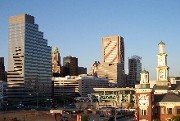Baltimore Transit Woes
Jacques Kelly hits it on the head in the Saturday, Dec 10 Baltimore Sun about the sad state of transit in Baltimore. In an essay focused on bus transit, he touches on a number of peculiarities of the Baltimore MTA, including the odd legacy of numbering and routing bus routes largely after the streetcar patterns of the 1960s. I won't repeat the whole essay here but it is worth a read for those who love city love and hate to see it decay.
Kelly does note that cities like Philadelphia, Chicago and New York - cities enjoyed for their urban merits by a large number of locals and visitors alike - have user-friendly, frequent and attractive transit systems including buses. Kelly described the mechanical failures of a 1989-vintage bus on a recent ride, i.e. a bus well past its mechanical useful life.
The following is my extensive indictment of the Baltimore transit "system."
1. The Metro does not connect to any non-local bus transportation mode directly. Not to the MARC, not to Amtrak and not to light rail, not to Greyhound and not to an airport.
2. The light rail does connect - poorly - to AMTRAK/MARC at Penn Station and to BWI and somewhat better to Camden Yards. The problem at Penn Station is that someone from the north cannot connect directly to Penn Station, but must wait in the rain at the University of Baltimore station for a one-stop northbound train that comes about every 36 minutes in rush hour - or walk 5 blocks. The problem for people south of downtown is that someone who is catching a MARC train to DC does not want to plug north through downtown traffic on a red-light hitting northbound trolley to catch a southbound fast train. Instead, they will drive to West Baltimore or Halethorpe and park for free, because time for a long-distance commuter is money. As for Camden Station, I suppose it is OK if you are actually going to a game, but taking a slow train north to catch a slow train south is madness.
3. The buses are slow, are inconvenient for rapid boarding and alighting and must push through Baltimore's slow, dull traffic grid.
4. The light rail and metro both avoid the most interesting tourist and entertainment centers except for Camden Yards and Lexington Market. They do not connect well with Harborplace, Little Italy, Fells Point, Canton, Federal Hill, Hampden, the Baltimore Zoo, Charles Village or Highlandtown. While one can walk to Harborplace from the Metro, it does not take tourists to that destination. If a tourist is not already staying within walking distance of the Inner Harbor, the metro will not shorten the trip because there are no hotels at Mondawmin Mall or at Upton/Lafayette Market, and never will be. Ditto for Lexington Market; a tourist trip there is not likely to be faciliated by the Metro or especially the light rail for a tourist.
5. There are exactly two rail stops in the entire system east of Charles Center - Market Place, walking distance from Charles Center, and the station at Johns Hopkins Hospital. It is conceivable that an out of town visitor will go to JHH from the downtown hotel base, but we don't typically hope for lots of sickness and lots of visiting relatives as a mark of urban success.
6. For residents, the service has been very limited. Unless you live in the Reisterstown Road corridor, the metro is almost useless. The light rail is slow and skips or misses stops in odd places. For example, the line passes through Ruxton and near Towson, but stops in neither. On the south end, it approaches Glen Burnie but does not stop at any interesting North Arundel destination (e.g. the courthouse, North Arundel Hospital, Marley Station Mall, etc.) The branch that goes to the airport does make an OK connection with the airport itself, but service is infrequent and the light rail does not connect with the Amtrak/MARC station at BWI, an unfortunate design weakness.
7. The city fathers and mothers have spent dearly to promote Baltimore as a tourist destination. Camden Yards and the almight hotel which this column has discussed are two examples. A city that does not provide the means for residents and visitors to get from place to place is essentially saying, "Stay Home!" whether home is in Dundalk or in New Jersey. Baltimore has one of the nation's lowest rates of dining-out per capita among medium-sized and large cities; perhaps it is part and parcel.
8. A brief trip to New York, Philadelphia or Washington will make the transit shortcomings of Baltimore painfully apparent. The DC Metro Red Line trains move through Union Station about one every 90 seconds at the height of rush hour; Baltimore's light rail service is 54 times less frequent out of Penn Station. At Union Station, the rail station has a large upscale mall with an large bookstore and magazine rack; no such bookstore in the central rail station of the City That Reads. Almost 700,000 people enter the DC metro daily; fewer than 85,000 enter the Baltimore metro and light rail combined each day. Baltimore is not that much smaller than DC.
9. When people in DC, Philadelphia and New York view transit, they view it as a useful means to get to a useful place to do interesting things. When many Baltimoreans consider mass transit, they view it as a sewage pipe piping Baltimore's social decay into their driveway. Tensions regarding race, class, economic status and the overpowering, mind-numbing crime statistics lead this hostility to transit. If you tried to take the DC Metro away from wealthy residents of Rockville or Falls Church or Alexandria, you would have a riot, but Baltimore's public hostility to transit has left us in the dust.
There is a plan to build a 100-odd station system in Baltimore over the next 40 years. Perhaps someone will wheel me and my oxygen tank onto the system when it is completed, if ever.
Bruce Godfrey at Crablaw's Maryland Weekly
Kelly does note that cities like Philadelphia, Chicago and New York - cities enjoyed for their urban merits by a large number of locals and visitors alike - have user-friendly, frequent and attractive transit systems including buses. Kelly described the mechanical failures of a 1989-vintage bus on a recent ride, i.e. a bus well past its mechanical useful life.
The following is my extensive indictment of the Baltimore transit "system."
1. The Metro does not connect to any non-local bus transportation mode directly. Not to the MARC, not to Amtrak and not to light rail, not to Greyhound and not to an airport.
2. The light rail does connect - poorly - to AMTRAK/MARC at Penn Station and to BWI and somewhat better to Camden Yards. The problem at Penn Station is that someone from the north cannot connect directly to Penn Station, but must wait in the rain at the University of Baltimore station for a one-stop northbound train that comes about every 36 minutes in rush hour - or walk 5 blocks. The problem for people south of downtown is that someone who is catching a MARC train to DC does not want to plug north through downtown traffic on a red-light hitting northbound trolley to catch a southbound fast train. Instead, they will drive to West Baltimore or Halethorpe and park for free, because time for a long-distance commuter is money. As for Camden Station, I suppose it is OK if you are actually going to a game, but taking a slow train north to catch a slow train south is madness.
3. The buses are slow, are inconvenient for rapid boarding and alighting and must push through Baltimore's slow, dull traffic grid.
4. The light rail and metro both avoid the most interesting tourist and entertainment centers except for Camden Yards and Lexington Market. They do not connect well with Harborplace, Little Italy, Fells Point, Canton, Federal Hill, Hampden, the Baltimore Zoo, Charles Village or Highlandtown. While one can walk to Harborplace from the Metro, it does not take tourists to that destination. If a tourist is not already staying within walking distance of the Inner Harbor, the metro will not shorten the trip because there are no hotels at Mondawmin Mall or at Upton/Lafayette Market, and never will be. Ditto for Lexington Market; a tourist trip there is not likely to be faciliated by the Metro or especially the light rail for a tourist.
5. There are exactly two rail stops in the entire system east of Charles Center - Market Place, walking distance from Charles Center, and the station at Johns Hopkins Hospital. It is conceivable that an out of town visitor will go to JHH from the downtown hotel base, but we don't typically hope for lots of sickness and lots of visiting relatives as a mark of urban success.
6. For residents, the service has been very limited. Unless you live in the Reisterstown Road corridor, the metro is almost useless. The light rail is slow and skips or misses stops in odd places. For example, the line passes through Ruxton and near Towson, but stops in neither. On the south end, it approaches Glen Burnie but does not stop at any interesting North Arundel destination (e.g. the courthouse, North Arundel Hospital, Marley Station Mall, etc.) The branch that goes to the airport does make an OK connection with the airport itself, but service is infrequent and the light rail does not connect with the Amtrak/MARC station at BWI, an unfortunate design weakness.
7. The city fathers and mothers have spent dearly to promote Baltimore as a tourist destination. Camden Yards and the almight hotel which this column has discussed are two examples. A city that does not provide the means for residents and visitors to get from place to place is essentially saying, "Stay Home!" whether home is in Dundalk or in New Jersey. Baltimore has one of the nation's lowest rates of dining-out per capita among medium-sized and large cities; perhaps it is part and parcel.
8. A brief trip to New York, Philadelphia or Washington will make the transit shortcomings of Baltimore painfully apparent. The DC Metro Red Line trains move through Union Station about one every 90 seconds at the height of rush hour; Baltimore's light rail service is 54 times less frequent out of Penn Station. At Union Station, the rail station has a large upscale mall with an large bookstore and magazine rack; no such bookstore in the central rail station of the City That Reads. Almost 700,000 people enter the DC metro daily; fewer than 85,000 enter the Baltimore metro and light rail combined each day. Baltimore is not that much smaller than DC.
9. When people in DC, Philadelphia and New York view transit, they view it as a useful means to get to a useful place to do interesting things. When many Baltimoreans consider mass transit, they view it as a sewage pipe piping Baltimore's social decay into their driveway. Tensions regarding race, class, economic status and the overpowering, mind-numbing crime statistics lead this hostility to transit. If you tried to take the DC Metro away from wealthy residents of Rockville or Falls Church or Alexandria, you would have a riot, but Baltimore's public hostility to transit has left us in the dust.
There is a plan to build a 100-odd station system in Baltimore over the next 40 years. Perhaps someone will wheel me and my oxygen tank onto the system when it is completed, if ever.
Bruce Godfrey at Crablaw's Maryland Weekly






0 Comments:
Post a Comment
<< Home